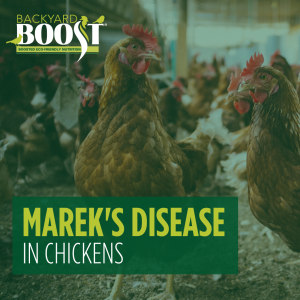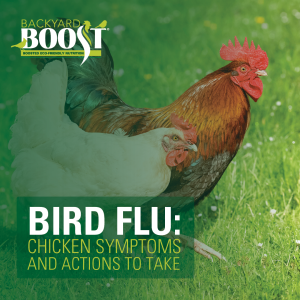
Molting Chickens
Have you noticed the number of feathers around your coop and on the ground increasing? It might seem like feathers are everywhere, and it might also seem like this happened overnight. At the same time, your hens are losing their feathers and have also gone on an egg-laying strike.
You are not, in fact, losing your mind. However, your chickens are losing their feathers! They are going through their annual molting process. That’s why Backyard Boost created this blog: to help educate you on molting and how to navigate it with your flock.
Here’s what you need to know about caring for molting chickens.
What Is Chicken Molting
Chicken molting is a ritual that occurs each year during late summer and early fall. During this process, the birds replace their old, disheveled feathers with new ones. At the same time, they funnel all their nutrient requirements away from egg laying to new feather production.
Like egg production, molt is triggered by the number of sunlight hours. It can last from 4 to 12 weeks.
The molting process typically follows a pattern, starting from the head and neck, progressing to the body, wings, and finally, the tail. While molting can make chickens look ragged and unkempt, it is a natural and necessary part of their life cycle to maintain their health and functionality.
How to Care for Molting Chickens
While molting chickens cannot be avoided, there are a few things you can do to help your girls stay healthy and comfortable throughout the process. Assisting your chickens through the molting process involves ensuring they receive proper nutrition, care, and a comfortable environment.
Here’s how to help:
1. Ensure a Stress-Free Environment
Since molting is a stressful situation, it is best to try to provide your chickens with a stress-free environment. Don’t you think your chickens are already a little afraid to see the only coat they know falling off of them? Handle your chickens as little as possible during the molting process since they are already sensitive and stressed.
Reduce additional stressors as much as possible. Keep their environment calm and quiet. Avoid introducing new chickens or other animals to their surroundings. Don’t make major changes to their living conditions during this time. Be sure to mitigate any additional stress by keeping a routine, not introducing new animals to the flock and maintaining as much normalcy as you can. Less overall stress in general can also help with overall egg production.
2. Maintain Good Coop Hygiene
Make sure their living area is clean, as molting will create an increased mess. Regularly clean the coop and replace bedding to reduce the risk of parasites and infections, which can be more problematic during molting.
Provide access to dust baths to help chickens naturally control mites and lice. Dust baths should be part of your coop set up year-round, but they are especially important during molting.
3. Provide Comfort
Especially as the fall weather turns cooler and the chickens are in between feathers, they will require some extra TLC. Consider extra bedding like straw that they can nest into. If they are losing their feathers as the temperatures turn even colder, consider a coop heater.
Be cautious of the temperature a heater generates—you don’t want to make your chickens too hot. Also be mindful of potential fire hazards. There’s a time and a place for fried chicken, and your backyard flock shouldn’t be involved. Experts also advise against sweaters for chickens during the molting stage as their new pin feathers are sensitive and the pressure of the sweater could cause extra pain and stress.
Be sure your coop is well-insulated and draft-free, as chickens with fewer feathers are more vulnerable to cold. Finally, make sure roosting bars are comfortable and ample space is available for all chickens.
4. Monitor Health
Keep an eye on your girls’ overall health and behavior by providing regular health checks. Look for signs of illness or severe feather loss that could indicate a problem beyond normal molting.
Always provide fresh, clean water, as hydration is crucial for overall health and feather growth. Water is the most essential nutrient for every living being, and it helps eliminate stress. Be sure to provide your girls with fresh, clean water at least once a day. Especially during molt and times of stress, add Backyard Boost® Defense to their water.
Backyard Boost Defense is a liquid supplement for poultry designed to support digestion and a healthy immune response. In addition to Amaferm, it provides nutrients needed in times of stress and promotes water intake and hydration.
By focusing on these areas, you can help your chickens navigate the molting process more comfortably and efficiently.
5. Provide High-Quality Nutrition
Feathers consist of 85% protein. Therefore, as they are losing old feathers and growing new, their nutritional needs are increased. Be sure to provide them the best diet you can, such as a supplement like Backyard Boost® Daily Essentials.
Backyard Boost Daily Essentials is a pelleted protein supplement for poultry designed to maximize digestibility and egg production. The added protein helps replenish and nourish your chicken during this time, and year-round. This pelleted protein supplement is fully fortified with the research-proven prebiotic, AO-Biotics® Amaferm®. It also contains vitamins, minerals and organic trace minerals to maximize growth and egg production and support overall flock health.
Amaferm enhances digestibility, aiding in the overall nutrition of the flock.
In addition to providing nutrients needed for overall well-being, Backyard Boost Daily Essentials also contains AO-Biotics® EQE, a postbiotic research-proven to enhance egg quality. AO-Biotics EQE is the first-and-only AO postbiotic developed specifically for layers. So, although they might be on an egg laying hiatus during molting, chickens will increase their overall productivity once they begin laying again.
AO-Biotics EQE is research-proven to:
- Result in more sellable eggs.
- Improve egg mass.
- Increase productive life span.
What You Need to Know About Molting Chicken Nutrition
As we’ve already established, Backyard Boost is a crucial tool for supporting your molting chickens. But why is nutrition so important? It plays a crucial role in helping chickens molt effectively and maintain their health during this period.
Feathers are made primarily of keratin, a protein. During molting, chickens need higher levels of protein to produce new feathers. Ensuring a protein-rich diet helps them grow strong, healthy feathers. Vitamins and minerals play significant roles in feather development and general health. Vitamins such as A, D, and E, along with minerals like zinc and selenium, contribute to feather quality and immune function.
Molting is also a physically demanding process. Chickens require additional energy to support the metabolic demands of feather growth. A diet with adequate energy content helps chickens meet these increased energy needs.
Although egg production typically decreases during molting, chickens still need calcium. Calcium supports the chicken’s overall health, including bone strength.
Proper nutrition feeds into every aspect of the molting process, from lower egg production to feather replacement. If they’re not getting the nutrients they need, your feathery friend may find molting far more challenging.
Nutritional Strategies for Molting Chickens
Molting is a natural occurrence that will happen annually for your flock, regardless of if they are ready or not. Now that you know the importance of nutrition in that process, what should you do?
Well, besides feeding your molting chickens Backyard Boost products, you should:
- Provide feeds with higher protein content, such as commercial molting feeds or supplements like fish meal, soybean meal, or mealworms.
- Ensure your flock’s diet is well-rounded with the necessary vitamins and minerals. Using poultry-specific supplements can be beneficial.
- Include sources of healthy fats to provide extra energy, such as sunflower seeds or flaxseeds.
- Always provide fresh water, as hydration is critical for overall health and metabolic processes.
What Causes Hens to Molt?
Especially if you are new to backyard chicken production, you are probably asking, why is your flock molting? Chickens experience the molt process for 5 simple, yet necessary reasons. Let’s learn more about their purposes for molting.
1. Feather Renewal
Molting allows chickens to shed old, worn-out feathers and grow new ones. Feathers are crucial for protection, insulation and flight, even for domesticated chickens, which rarely fly. New feathers help maintain body temperature and provide better protection against the elements.
2. Energy Conservation
During molting, chickens will typically reduce egg production or cease laying altogether due to the fact growing new feathers requires a significant amount of energy and nutrients. By pausing egg production, chickens can redirect their energy and nutritional resources to feather growth.
3. Health & Hygiene
Molting helps chickens get rid of damaged or parasitized feathers, which can harbor parasites like mites and lice. Growing new feathers can help improve the overall health of your hens and reduce the risk of infestations.
4. Seasonal Adaptation
Chicken molting often occurs in response to changes in daylight length and seasonal temperatures. For instance, many hens molt in the late summer or early fall in preparation for the colder months. New feathers provide better insulation against the cold.
5. Compromised Health
As scary as this may initially sound, molting can also be a response to stress or poor health. If a chicken is sick or experiencing nutritional deficiencies, it might molt to help recover and maintain overall health. There’s no need to panic, though—supporting sick molting chickens with proper attention, nutrition, and care makes all the difference. We offer a variety of resources to help ensure healthy hens.
Give your Birds Boosted Eco-Friendly Nutrition During Molting
You can best prepare them for molting by providing them with the best nutrition available since extra nutrients are required for both feather and egg production.
While your chickens are experiencing the stress of changing their feathers, keep them feeling their best, keeping them healthy, and keeping them laying. Products powered by Amaferm can provide them with high-quality nutrition and added protein.
Combine the Backyard Boost products with plenty of water, extra warmth, and bedding, and your chickens will conquer molting.
Get your Backyard Boost Today!
Do you have molting chickens in your yard? Well, Backyard Boost can help. Get your hands on industry-leading backyard chicken supplements now!
Ordering Backyard Boost is simple: check out our online store or one of our online retail partners.
Perhaps you prefer to shop in person. You can use our dealer locator to find a BioZyme dealer closest to you.
Do you want to know more about taking care of your backyard birds? Use our Chicken Care Cycle as your guide to all knowledge of backyard chickens. Or you can simply sign up for our regular electronic newsletter to stay current on our blogs and other education.

